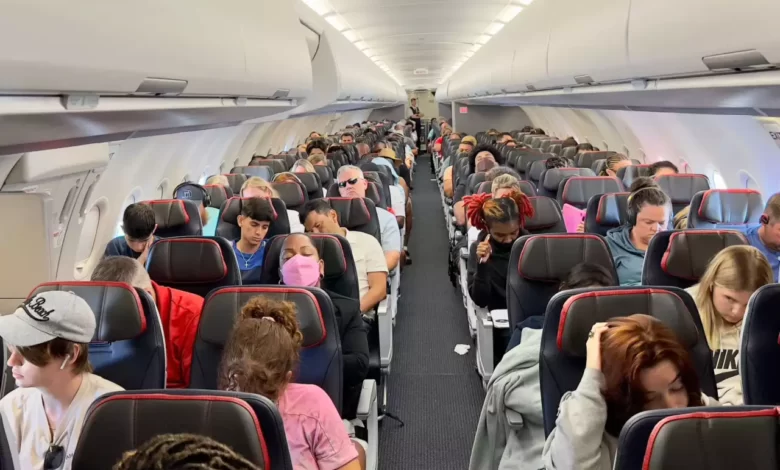
7 Plane Toilet Mistakes
Air travel can be stressful, and passengers often prioritize their seating arrangement and legroom. However, there’s one aspect of flying that passengers should pay more attention to: the airplane toilets.
According to a former flight attendant who worked for a major airline, airplane lavatories are widely considered the dirtiest place on the plane.
The bathroom specialists at Sanctuary Bathrooms interviewed the former flight attendant, who shared insights on airplane lavatories and how to use them correctly.
The former flight attendant provided several tips on using airplane toilets. First, they advised passengers to avoid using the bathroom during take-off and landing, as the turbulence can make it challenging to use the facilities safely.
Credit Relationship Manager Vacancy | HDB Financial Services | TN JOB ACADEMY
Second, they revealed that airplane toilets are usually cleaned every four hours, so passengers should try to use them early on in the flight.
Third, they recommended washing hands thoroughly after using the lavatory and avoiding touching surfaces unnecessarily.
Overall, while passengers may not think about airplane toilets often, they can play a crucial role in ensuring a comfortable and hygienic flight experience.
By following the tips shared by the former flight attendant, passengers can stay clean and healthy while flying.
Wear a Mask in the Airplane Bathroom
According to a former flight attendant, wearing a mask in the airplane bathroom is a crucial safety measure to take. The airplane toilet has poor air ventilation, which means that every time someone uses it, they are breathing the same air as many others who have used it before them.
Additionally, the potential airborne fecal particles released during toilet flushing can be a source of contamination.
To reduce the risk of exposure to germs and viruses, passengers should wear a mask when using the airplane lavatory, especially during long-haul flights.
Avoid Brushing Your Teeth in Airplane Bathrooms
A former flight attendant advises against brushing your teeth in airplane toilets. The water used in the lavatory comes from the same tank as the drinking water, which is not filtered.
This means that the water may contain bacteria and other contaminants that could be harmful to your health.
Saudi Arabia Wanted Engineer, Manager, Inspector & Water Jet Operator | TN JOB ACADEMY
If necessary, passengers should use bottled water for brushing their teeth. However, the best advice is to keep toothbrushes and other personal hygiene items away from airplane lavatories.
Avoid Touching Surfaces in Airplane Bathrooms
A former flight attendant recommends avoiding direct contact with any surface in airplane lavatories. This includes using your foot or disposable gloves to touch the handle and avoiding touching the toilet seat.
Most lavatories have washcloths by the sink, which can be used to touch surfaces without direct contact. By taking these precautions, passengers can reduce their risk of exposure to germs and bacteria in airplane toilets.
How Often are Airplane Bathrooms Cleaned?
According to a former flight attendant, due to billing priorities, complete and deep cleaning of airplane toilets may not always be possible, and they are usually only given a quick cleaning before take-off and checked every half hour during flights.
If there are more urgent issues, cleaning the bathroom falls lower on the priority list. Additionally, the former attendant warned that waste-water tanks may not be emptied immediately after landing, especially during busy periods, which could result in a risk of overflow and contamination.
To reduce the risk of exposure to germs and bacteria in airplane bathrooms, passengers should avoid touching surfaces directly with their fingertips, and instead, use a few sheets of toilet paper or their knuckles to avoid direct contact.
They should also wipe down or cover any handles or buttons they need to touch before using them, as well as hover over the toilet seat to avoid sitting on it.
By taking these precautions, passengers can protect themselves from potential health risks associated with airplane toilets, which are often considered the dirtiest places on the plane due to poor ventilation and infrequent cleaning.

Shower immediately after your flight
The airplane’s poor air circulation and the various surfaces that can harbour a large number of germs can leave travellers with dirty hands, hair, and clothes.
A former flight attendant suggests that as soon as passengers arrive at their destination, they should wash their clothes and take a shower to rid themselves of germs.
They also recommended showering right after work and sometimes finding the water turning brown due to the job’s dirtiness.
Keep your shoes on to avoid germs on the plane.
Walking around the airplane in socks or barefoot may sound tempting, especially on a long flight. However, according to a former flight attendant, this is a big no-no.
There are a high likelihood of imbalance and people missing the toilet bowl, which could leave urine on the floor.
9 Tips from Taqa (To Stay) – Campaign to Save Fuel While Driving | Gulf Insights
If you take off your shoes and step on the urine, you may be carrying germs from the plane to your home. So, it’s best to keep your shoes on to avoid any potential germs.
Bring Hand Sanitizer and Use it Frequently.
With the ongoing pandemic, frequent hand washing, and use of hand sanitizer have become essential for personal hygiene. This is especially true when traveling, including using airplane restrooms.
Former cabin crew members recommend carrying pocket-sized bottles of hand sanitizer to use when needed, particularly before and after using the bathroom.
They emphasize the importance of using hand sanitizer in addition to washing hands with soap for extra protection against germs and viruses.
Avoid Using Airplane Restrooms at Certain Times
A former airline steward advises that it is best to avoid using the airplane toilet bathroom right before take-off and at the end of a flight, especially on long-haul flights.
Saudi Skill Verification exam launched in Bangladesh for workers
This is because they are often just as bad after a patchy turbulence point, during which the seatbelt signals would have to be on, resulting in a rush of people needing to use the bathroom as soon as the signs go out.
The former flight attendant also recommends trying to use the bathroom on the flight before food is served, as airplane food can be oily and rich in salt and fat, which may cause gastrointestinal discomfort.



